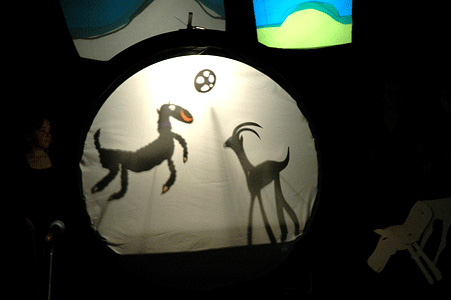Planning Together
There are many ways that an artist and a classroom teacher can build a successful working relationship around their shared aims for promoting the wellbeing of students. Mary French, who is both an accomplished community artist and a primary school teacher in western Victoria, has a natural affinity with the worlds of arts and education as well as a strong understanding and commitment to community values. Mary shares with us a sample of an approach to working as an artist with a teacher on a nine-week creative workshop program with a grade 3/4 class who were into puppets…

An Example of the Creative Process – The Warracknabeal Festival for Healthy Living – A Nine-Session Plan
The lesson plan outlined here was devised by artist and teacher Mary French, for a puppet performance project done with grades 3 and 4 students at Warracknabeal Primary School in Western Victoria.
Mary writes:
It was an interesting process for me: interesting to see how the teacher’s role grew from being a participant in the activities to working closely in partnership with the artist. This just evolved naturally as we got to know each other. The plan also demonstrates where the artist gave lots of freedom for ideas and play and when things were more manipulated and directed.
The four-phases model could also be useful to teachers, especially when contrasted with the traditional model (begin with a script, score etc; rehearse; perform). It could be an interesting activity to develop and refine these models with the input of the Artists Co-ordinators. I think it would help teachers to understand the process. Ideally, I would imagine the employed artists might get together to produce a planner/timeline.
Background to the Warracknabeal Primary School Project
This project involved a shadow puppet performance with 20 grade 3/4 students. The premise at the start was that they would be doing “something” with shadow puppetry in the show. The project involved six artists. Mary describes the process as follows:
Each artist spent 2.5 hours, once a month for seven months (total time: approx 18 hours with their groups of 20 students). All artists met together on the same two days. Extra rehearsals took place in the final weeks.
The artist and teacher approached each class with a loose plan, to allow flexible responses and adaption of material when appropriate. For example, the artist would have had a number of games to choose from to play but the decision of which ones to use would have been made during the class – UNLESS the teacher was to play a specific part in an activity that had been arranged prior to the class starting. However, as we got to know the teacher better, we could quickly communicate during the classes and devise roles as we went along.
This is a sample of one way of working and at other times the process may be different. Other artists will work in slightly different ways. Almost always however, there will be a series of phases, such as:
- Getting to know students and establishing a rapport
- Gathering ideas and material and identifying skills
- Bringing elements together to create a script or a performance
- Rehearsal and performance.
Below is the lesson plan Mary’s project used, with each professional’s role outlined:
| SESSION | AIMS | Artist’s Role | Teacher’s Role | Health Professional’s Role |
| 1: INTRODUCTION | General introduction for students and teachers. An explanation of the process to be followed over the next months. All students got to meet and work briefly with all artists. | Brief group introduction to the festival for all 160 students at two primary schools. Students participated in a half-hour activity with each of the six artists. | Assisted with organisation and crowd control. Modelled “having a go with enthusiasm” by actively joining in all activities. |
Health professionals actively participated in the activities. |
| 2: GETTING TO KNOW YOU | Getting to know students and the teacher you are working with and establishing a level of trust. Introduce the medium the students will be working with (shadow puppetry). Everyone needs to have fun. The artist is also looking for individual student strengths, potential leaders, and ideas for material. These often arise unexpectedly through the process of play and exploration. |
1. Name game (getting to know you).2. Fruit salad game (empathy).
3. Zap the clap game (team work). 4. Statues drama game (working together). 5. Introduction to shadow play. 6. Students make a shadow puppet to take home. 7. Students present their puppet to the class in small groups. 8. Summary. |
The teacher’s enjoyment of the activity and trust in the artist helped students to adjust to the new experience. The teacher conducted a summary of the day’s activity. |
Health professional conducted an activity in the classroom on a different day addressing a specific topic requested by the teacher. |
| 3: GETTING TO KNOW YOU AND EXPLORATION OF MATERIAL | The artist, together with the teacher and a health professional explores a number of themes with the students, keeping an alert eye open for interesting and meaningful ideas that may arise during the process of play and exploration. | 1. Name game.2. Zap the clap game.
3. Animal statues game. 4. Health professional delivered a game exploring the theme “life’s ups and downs”: What can/do we do when we are feeling sad to feel better? 5. Students draw images of activities that make them feel happy—things they love doing.” 6. Share drawings. Artist collects drawings for future reference. 7. Summary delivered by teacher and health professional. |
A discussion with the teacher helped to plan this class and introduce the theme of life’s ups and downs | A discussion with the health professional helped to plan this class and introduce the theme of life’s ups and downs. |
| 4: BRINGING IT ALL TOGETHER | Continuing to explore ideas but beginning to make decisions about content for the performance. | 1. Name game.
2. Students are introduced to the song “Animals on the Farm,” 3. The artist explained how impressed they were with their animal portrayals in animal statues and the good ideas in their drawings and how these elements fitted with the song. The question was asked: Do you think this song would be useful to us for our puppet performance? The students made suggestions about how the song could be illustrated using shadow puppetry. They then created an animal character of their own choice to illustrate the song. Ideas from free play with shadows and puppetry during previous sessions were also incorporated. 4. Summary. |
Teacher and artist had a discussion about drawing together some of the strong ideas produced in previous sessions, i.e. Animal statues, and drawings of activities that make us feel good. We also discussed the group dynamics and identified some of the skills and strengths present. | |
| 5: PUPPET MAKING | Puppet making workshop | 1. Game.
2. Revisiting and singing the “Animals on the Farm” song. 3. Puppet making: designing puppets referring to drawings created in the previous session. 4. Making a puppet prototype. 5. Summary and looking forward to the next session. |
Assisted with puppet making. Watched carefully for students who were struggling with the activity. |
Assisted with puppet making. Supported a student who had an ambitious puppet to make. |
| 6: EXPLORING WHAT THE PUPPETS CAN DO | In preparation for this session the artist and parent helpers made copies of the student prototype puppets from strong materials that would last the distance. This level of student couldn’t cut the materials we used to make the puppets. However the students finished off their puppets by adding coloured gels and final decorative details. In this session we developed the actions puppets would make to illustrate the song and worked out the staging. |
1. Introductory game.
2. Tai Chi. 3. Movement exercises in preparation for using the puppets. 4. Adding gels and final details to puppets. 5 – Students worked in small groups to design actions for their puppets. 6. Each group presented their actions to the class. 7. Summary and looking forward to the next session, e.g. look at costuming (find something black or dark to wear). |
Teacher joined in all activities and assisted with puppet making. She kept a close eye out for students who were feeling challenged by the activity and quietly supported these students. | Tai Chi One of the health professionals taught Tai Chi and as our class was quite highly strung we thought learning some relaxation movements and techniques would be helpful |
| EXTRA TIME | The artist adjusted any puppets that were not quite working and worked with small groups to develop confidence using puppets and learning actions. | |||
| 7: PUTTING IT ALL TOGETHER | Refining the performance and practising working together to produce the performance. Looking at the issues involved in being a performer. |
1. Tai Chi warm up.2. Rehearsal for the show.
3. Relaxation game and summary. |
Worked in partnership with the artist to assist students to find their places and work with the puppets | Activities and discussion about being a performer: i.e. feeling nervous and strategies to cope with “stage fright.” Was available for short class activities if required. |
| 8: GROUP REHEARSAL | Site orientation – learning about the performance space. Introduction to support crew: Stage manager, sound and lighting crew etc. Rehearsing the group item with the rest of the performers. |
1. Working out movement patterns for performers, i.e. how to get on and off stage and where to sit during the show.2. Rehearsing individual items on stage.
3. Debrief. |
Teacher (who knew the performance as well as the students and artist) worked closely with the artist to direct one group of students while the artist directed the other. Between times, the teacher made time for students to raise concerns, listen to the music to be used in the performance and practise the finale song all students performed. |
Was available for short class activities if required. |
| 9: FINAL REHEARSAL AND PERFORMANCES | Final rehearsals and the show. The reward at the end of the journey | Directing the rehearsal and performances. | Teacher (who knew the performance as well as the students and artist) worked closely with the artist to direct one group of students while the artist directed the other. Teacher stays with her group leaving the artist free to direct other aspects of the show e.g. the puppet lantern parade. |
Health professionals assisted with stage management. Specific roles were allocated. On hand to support artist, teachers and students. |
